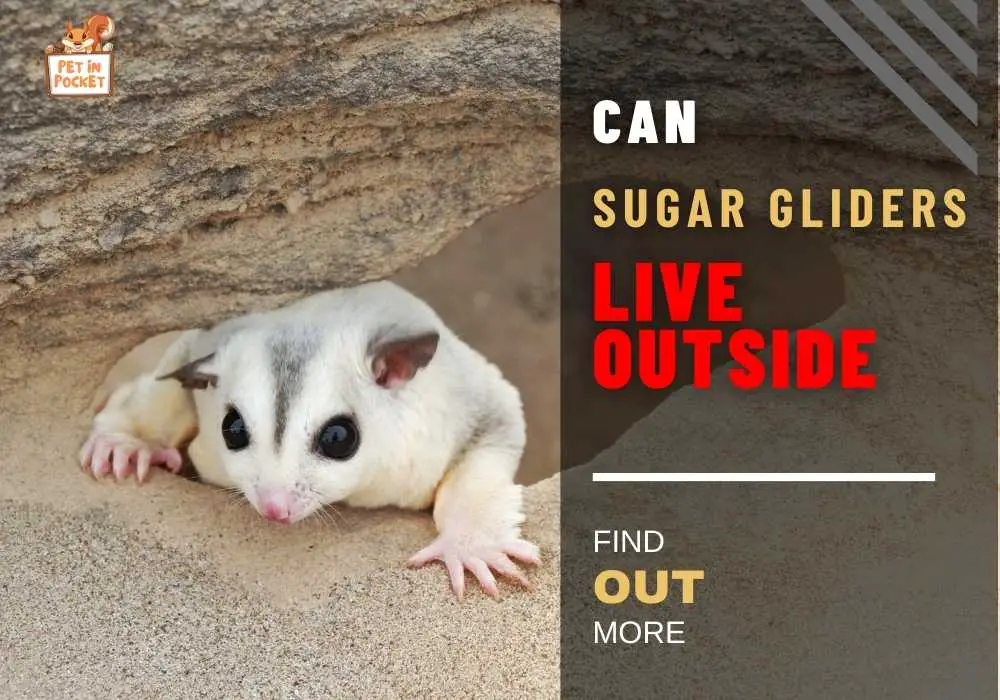If you’re interested to know about Sugar Gliders then, their wild lifestyle will be your major concern! Their surviving methods can be one of the most amazing facts for an animal enthusiast! So are you excited to know what trees Sugar Gliders live in! Keep reading to explore!
Usually, Sugar Gliders live in large trees. Tree hollows are their most preferable place in this regard. Sugar Gliders make their own home with straw, dry, or fresh leaves. They are also comfortable living in a nest box. Here are all the details!
Where Sugar Glider’s Habitat Trees Are Mostly Found?

Sugar Gliders are mostly found in Australia, Indonesia, and Papua New Guinea. To be more specific, you will see the most in eastern Australia and northern Australia. Sugar Gliders mostly prefer to live in dried places but sometimes you will see them in rainforests. This small animal loves the shelter of cozy leaf nests. Wooded areas and open forests are at the top of their priority list. Securely finding food is also a major concern of wild Sugar Gliders.
Especially they go for the foods which are above ground. Sugar Gliders are likely to build homes in this type of tree from where they can obtain the necessities easily. Moreover, some of these trees also give them nutritious benefits.
Major facts about Gliders Tree Habitat
Before knowing about the trees some major facts should be kept in mind.
- Woodland and open forest are preferable for them.
- Hollow-bearing trees are the most secure place for them to build a nest.
- Trees that provide a winter source of nectar remain top of the list.
What Trees Do Sugar Gliders Live in?

Which trees Sugar Glider will choose to reside with, depends on many factors. They want to get the highest benefit from the residing trees. Here are some of the trees in which Sugar Gliders stay-
Eucalyptus Tree
This tree is the home of many wild animals. Eucalyptus trees are really large with a size of 30-800 feet. The aroma of this tree is also liked by Sugar Gliders. They even eat the fresh leaves of this tree. Sugar Gliders also use the leaves of these trees as sleeping pouches. Moreover, the sap that drips from the branches of Eucalyptus trees is their favorite food.
Acacia Dealbata
This is one of the common trees where you will find a Sugar Gliders nest. This tall tree, consisting of yellow flowers, is not only a dependable residing place for the Sugar Gliders but also a source of food. The gum of Acacia trees is very useful for Sugar Gliders. They spend nearly half of their time in the wild feeding on the gum of this tree. This gum fills up their carbohydrate demand. All over, this tree can manage their food habits along with giving them a suitable place to live.
Acacia Mearnsii
Acacia Mearnsii is a type of flowering plant, commonly known as black wattle, late black wattle, and green wattle. It is also a large-sized tree. The sap of this tree is also a good source of energy for the Gliders. It is often noticed that the group Sugar Glider defends their wattle trees from other Gliders. The tree hollows of this plant are also comfortable places for them to live.
Acacia Melanoxylon

This tree offers protected nesting areas for Sugar Gliders. The nourishing protein-rich sap of this tree is very useful for the health of wild Sugar Gliders. Moreover, they tend to establish their territory here and mark it safe from other Sugar Gliders. People often call this tree Hickory.
Banksia Tree
Banksia is also a familiar tree for Sugar Gliders. There are many benefits of the Banksia plan that Sugar Glider often prioritizes to live here. This tree is a rich source of inflorescences, pollen, and nectar. There are various sizes of Banksia species. Banksia Integrifolia is one of them that is average in size. You will find this tree mostly in Australia from Victoria to Queensland.
Silver Wattle
This type of tree grows very fast and is likely to be discovered on a variety of soils. You will see this tree a lot in Australia. Silver Wattle is also an excellent habitat for Sugar Gliders. The gum of this tree is flavored and Sugar Gliders love this. The timber of this tree is also appropriate for giving enough protection and safety to them. Lastly, this tree can easily tolerate strong winds.
Acacia Implexa
Sugar Gliders mostly live in the big Acacia Implexa trees. The large Implexa trees are over 6 meters long. People often call this tree “Lightwood”. The dry and moist condition of this tree has made it a safe option for Sugar Gliders.
Corymbia
This tree looks a lot different from the other trees. The tank of this tree is usually so rough. Moreover, you will see the marks of Sugar Glider’s teeth on it as they eat the sap released by this tree. This tree is not a suitable option for Gliders but in emergencies, they live here.
Angophora
Angophora trees are mostly found in eastern Australia and have fresh leaves. It has a smooth pinking or orangish bark. This tree grows mostly 30 meters. Sugar Gliders can easily live here and use the leaf for building the nest.
How Sugar Gliders Arrange Their House in Trees?
Sugar Gliders usually look for fresh leaves. and Then they place them in a circular function inside their nest. Sugar Gliders collect these leaves for a long time. An interesting fact is, that wild Sugar Gliders are mostly neat freaks and they choose the clean leaves. For this reason, the whole structure smells nice.
What Are The Main Food They Get From These Trees?

Sugar Gliders can get the necessary food sources from these trees. They evaluate their diet according to the environment and the resource availability. Of course, they have to go hunting for insects but here are the foods that they majority get from the trees-
- Nectar
- Pollen
- Tree gum
- Tree Sap
- Invertebrates
- Honeydew
- Tree Leaves
All over 48% of their wild diet consists of searching for insects and depends on tree pollen and nectar. invertebrates contain 35% of the diet. Finally, 15%-16% honeydew is needed with 2% lerps.
What Are The Threats to Live in These Trees?
In the wild, undoubtedly Sugar Gliders are open to many threats. As Sugar Gliders like to live in a comparatively clean environment, they often face difficulties with this. There is also a major risk from wild dogs, foxes, and snakes. Lastly, they suffer from habitat fragmentation.
Conclusion
This is everything you need to know about the preferred trees for Sugar Gliders. If you want to make any natural habitat for your Gliders, you should plant these trees! Certainly, these trees also have a big impact on their food habits!
Moreover, if you are a Glider-loving person, place a nest box in these trees! Just check the nest box’s setup properly and put some fresh leaves in it.
FAQ
How many Sugar Gliders can live in trees?
Around 10 adults can live together in a tree. The young Sugar Glider stays with the family till they turn 7-10 months old.
What type of tree leaves do Sugar Gliders prefer to eat?
Sugar Gliders love leaves that are fresh and young. This type of leaf consists of a level of nitrogen and low fiber.
Are there any other trees that produce Sugar Glider food?
Yes, many sugar gliders love to eat the young cones of pine trees. Moreover, some of them also like to eat some part of the Mistletoe tree.
What type of forest temperature is good for Sugar Gliders?
The ideal range of temperature for them is 24° to 27° C. For this reason, they prefer to live in an open forest. However, they can tolerate the highest temperature of 32.2° C.
Is the tree a safe habitat for Sugar Gliders?
Yes, as Sugar Gliders are energetic animals and look for security, choosing an appropriate tree is safe for Gliders. They can get their necessary foods from trees and stay healthy.






Leave a Reply